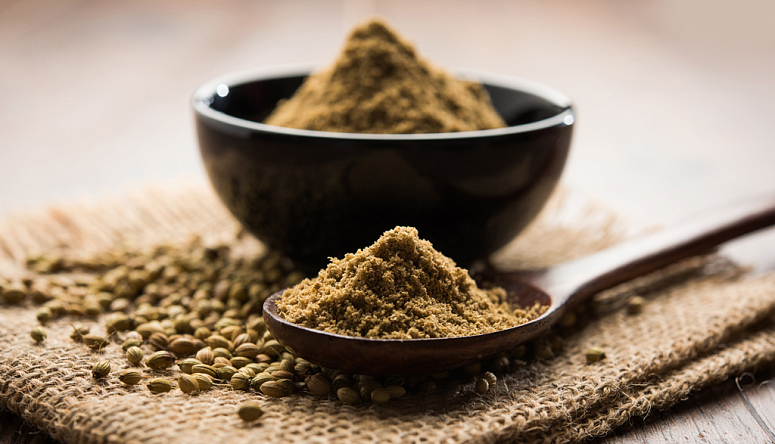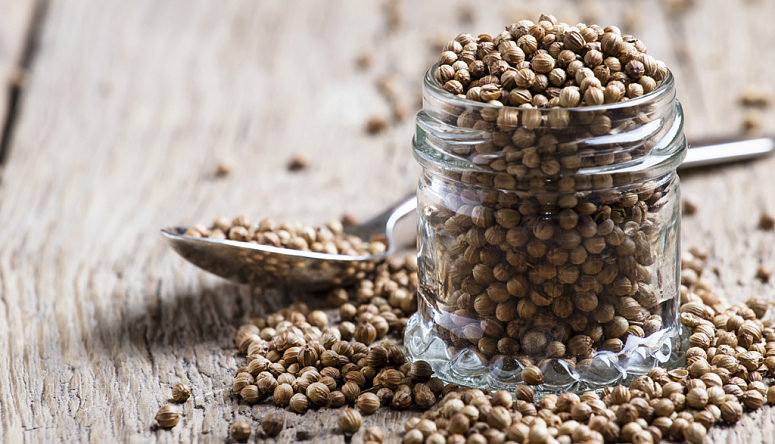Many of us are familiar with coriander from childhood: cilantro, or coriander greens, continues to be grown in summer cottages and vegetable gardens, and the spice itself is commonly sprinkled on our beloved Borodinsky bread. The ancient science of healing, Ayurveda, says that to treat disease, a person must use the plants that grow near them- and for the Russian people, this happens to be just that plant. In this new material, we’ll find out what makes coriander seeds useful from the point of view of Ayurveda and what diseases this spice can save us from.
Coriander: description and useful properties
In biology, coriander is known as Coriándrum sátivum and is classified as an annual plant of the umbelliferae family. It is noteworthy that this plant takes its name from the Greek term for “bug” due to the fact that young coriander sprouts emit a smell similar to that of a stink bug. However, the unpleasant smell disappears once the plant is dried and decyl aldehyde, which accounts for 60-80% of the plant’s essential oils, is evaporated.
Today, the origin country of this spice remains unknown. It is generally believed that the fruits or coriander were brought to Europe by the Romans and later, having gained recognition, coriander spread through the world.
Coriander came to Russia around the 18th century through merchants from the East. At that time, the spice was called “kishnets,” which is consonant with its Turkish (kişniş) and Afghan (گشنيز, geshniz) names. Many decades passed before the Russian people began using coriander as a spice; in the 1960s, it was still considered a weed and required weeding. Today, however, it is known that the plant’s fruits contain essential and fatty oils, ascorbic acid, pectin, and protein.
The composition of coriander makes it an essential component of products meant to improve digestion and stimulate appetite. Remedies containing coriander are used to treat diseases of the gallbladder and liver, as well as flatulence. Coriander oil is an excellent expectorant and can restore the senses of smell and taste. The fruits of this plant, as well as mint and clover, also greatly enhance the properties of choleretic tea.
Ancient Egyptians used coriander not only for healing purposes but in cooking and burial rites. It came to China in the 4th century and also actively served for a variety of purposes.
Interestingly, coriander oil is used today to synthesize linalyl acetate, which allows perfumes to smell like bergamot, lily, or lemon. The oil is also used in the soap-making and textile industries.
As noted above, coriander’s composition has given it application in medicine, specifically folk medicine. It is often included in choleretic and gastric herbal remedies or collections.
Linalool, a part of coriander oil, is used to create bactericidal drops and antibacterial candies. Coriander oil is an essential element in the synthesis of citral aldehyde, which serves a variety of purposes including the treatment of conjunctivitis, glaucoma, and cracks in the mammary glands of nursing mothers.
In Russia, healers used this plant to treat colds and improve appetite, while its powder was a remedy for flatulence. And oh, it’s hard to imagine the number of culinary recipes containing coriander- it is added to soups and salads, smoothies and main courses. Cilantro is especially popular in the Caucasus region.
Use of coriander in Ayurveda
Let’s talk about the role of coriander in Ayurveda, it’s applications and contraindications. The composition of coriander is unique not only from a scientific but also from an Ayurvedic point of view. The spice has madhura - a bright, sweet taste - and is also spicy, bitter, and astringent. It has fiery virya.
Due to this composition, coriander affects all three doshas. It is highly valued for its qualities and is added to many medicinal remedies. The spice is also used in Ayurveda to influence dipana (appetite), remove ama (toxins) from the body, treat sulapasamana (flatulence), and as an antiviral agent. It perfectly reduces dahagna (temperature) and lifts the mood, which is no less important in the treatment of various diseases.
Sushruta, author of the Sushruta Samhita, claimed that there is no better remedy for fever and pain than coriander. For example, the following recipe will help eliminate discomfort in the stomach: 1 tsp of coriander seeds or ½ tsp of coriander powder poured in a glass of boiling water and drunk like regular tea. Adding pomegranate peels to the described recipe will give you a remedy for diarrhea; a similar effect can be achieved by adding ½ tsp of coriander powder to a glass of pomegranate juice.
Coriander tea is recommended for anyone struggling with excess weight- its composition allows you to reduce the proportion of fat. This hot drink is also invaluable for women during PMS. To experience its benefits, you’ll need to pour a glass of warm water over two tablespoons of coriander in the evening, drink the resulting infusion immediately after waking up, and drink this tea during the day, adding in lemon juice.
For those with conjunctivitis, it’s recommended to use a strong coriander infusion to cleanse your eyes; pour a cup of boiling water over 1 tbsp of seeds, let cool, and use for rinsing.
If you suffer from rashes, you should take 1 tsp of fresh coriander juice three times daily. However, remember that any of the described remedies can only be used at a doctor’s discretion. Do not self-medicate under any circumstances. The suggested recipes are for guidance only.
But what everyone can do without exception is eat healthy and delicious dishes from coriander. Let’s begin with the most appetizing: applesauce. For this, we’ll need 4 cups of chopped apples, 1 cup of water, 2 tbsp of sugar, ½ tsp of ground coriander, and a pinch of cinnamon. Place the apples in a pan, add water and spices, and keep on medium heat for 5-6 minutes before adding sugar. When the paste becomes homogeneous and thick, it is ready. You can eat it with bread or tea.
Another recipe that will diversify your diet is delicious vegetarian meatballs, a dish that is very filling due to the chickpeas it contains. We will need: 300g (about 1 ¾ cups) of this ingredient, the same amount of mushrooms, one carrot, one onion, oil for frying, ½ tsp of coriander powder, and a sprinkle of turmeric and sweet paprika. Add pepper and salt to taste. Pre-soak the chickpeas overnight so you can boil them the next day. Finely chop the onion and carrot and saute them, stirring frequently. Fry the mushrooms in a separate pan. Drain the liquid from the chickpeas and put them in a blender bowl, adding salt, pepper, and other spices. Mix and transfer them to a bowl, then mix the vegetables and mushrooms in the blender. Next, add the vegetables to the chickpeas and mix to a doughy consistency.
Grease your hands with vegetable oil and roll the resulting dough into small balls, roughly the size of a walnut. Deep-fry the balls for a minute or bake them in an oven at 180 degrees Celsius (350 Fahrenheit) for 30 minutes. You can take chickpea meatballs to work or surprise family and guests with such a pleasantly unusual dish - these tasty and, more importantly, healthy meatballs will surely appeal to your gourmets at home!
Of course, the benefits of coriander seem obvious, but this does not mean that everybody can use it without restrictions. First, it is worth mentioning that individual intolerance or food allergies require adherence to a prescribed diet, therefore you must get permission from a doctor before adding this spice to your diet.
In addition, the spice should be avoided by those diagnosed with gastrointestinal or heart diseases. If you have problems with blood vessels, you should also refrain from consuming coriander.
Breastfeeding and expectant mothers can also add this seasoning to food, but consulting a specialist is generally recommended. Coriander can be added to children’s diets once they reach the age of three. Here, the opinions of doctors are unanimous: any spices can be given to older children.
Remember that in Ayurveda, everything is useful only in moderation. Be moderate and take care of yourself and your loved ones.

